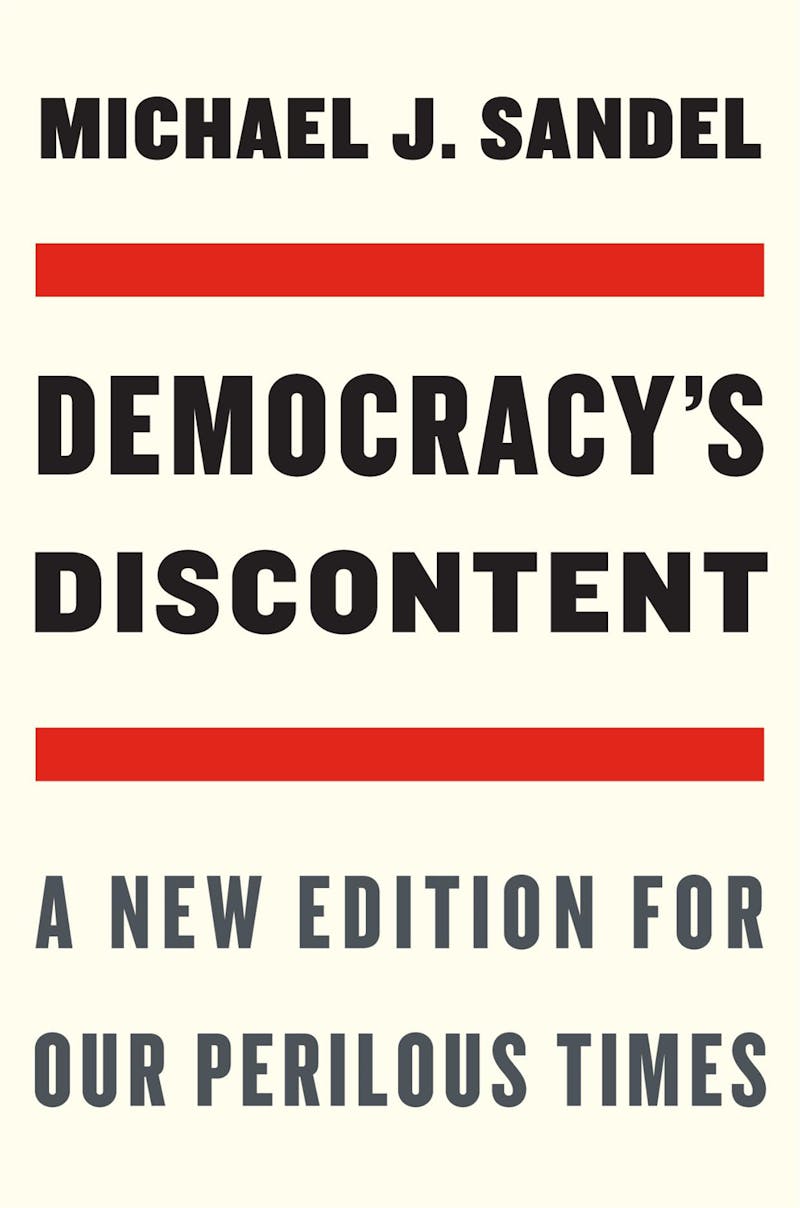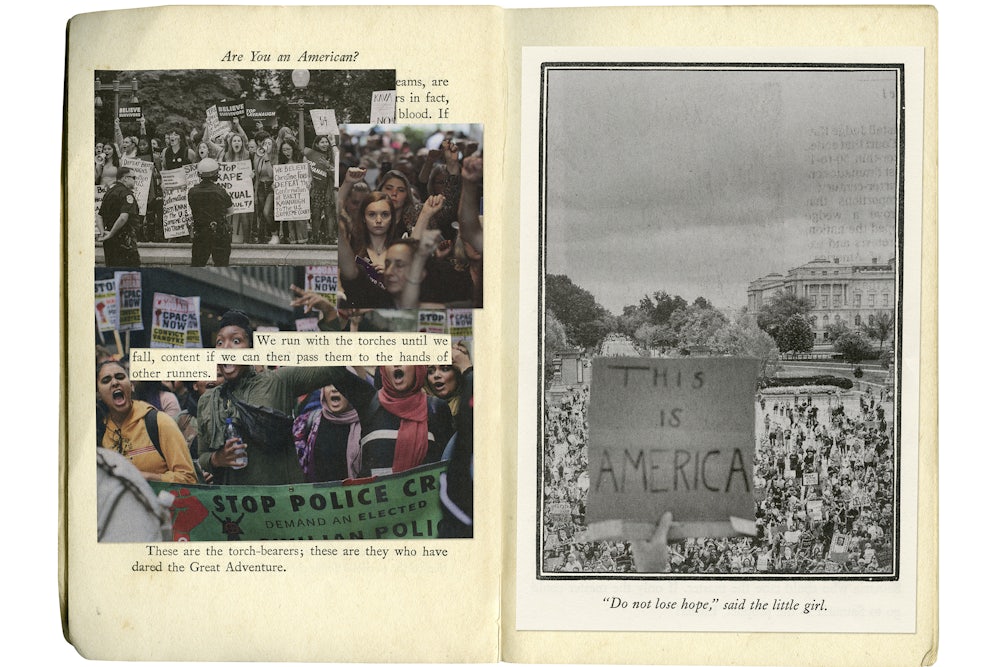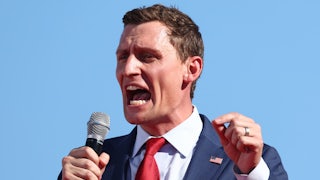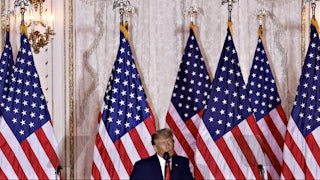In 1996, the philosopher Michael Sandel observed a significant feature of American public life. Americans, he noted, tended to consider political philosophy a discipline with only a tenuous connection to the real world. In the preface to his book Democracy’s Discontent: America in Search of a Public Philosophy, published that year, he wrote of the common notion that “Principles are one thing, politics another,” that “philosophy may indulge our moral aspirations, but politics deals in recalcitrant facts.”
This separation of principles and politics, he argued, was in fact an illusion, since “our practices and institutions” cannot help but embody values.
Political institutions are not simply instruments that implement ideas independently conceived; they are themselves embodiments of ideas. For all we may resist such ultimate questions as the meaning of justice and the nature of the good life, what we cannot escape is that we live some answer to these questions—we live some theory—all the time.
The aim of his book was to articulate “the theory implicit in our public life” with a view to “diagnose our political condition.” This undertaking, he proposed, might “reveal that the predicament of American democracy resides not only in the gap between our ideals and institutions, but also within the ideals themselves, and within the self-image our public life reflects.”

By the 1990s, the prevailing public philosophy was a form of liberalism that originated with John Locke and was developed further in the writings of Immanuel Kant, John Stuart Mill, and, most recently, John Rawls. Sandel calls this line of thought “procedural liberalism”—not to be confused with “egalitarian liberalism,” which focuses on expanding equality of various kinds among the citizenry. Procedural liberalism places “the right” over “the good.” What does that mean? Since every person nurtures his or her own personal conception of the good life, the state should remain neutral with regard to the moral and religious convictions of its citizens. Any other approach would be coercive, and a violation of people’s rights to freedom of thought and expression.
Sandel, by contrast, is committed to civic republicanism, a creed extending all the way back to Aristotle, who taught that the higher purpose of a political order (the baser one being self-serving commerce) involved the search for the good life. This search is necessarily a collective endeavor; that is a principal reason, Aristotle thought, that individuals congregate together in a polis in the first place. As Sandel points out, “this idea is not by itself inconsistent with liberal freedom. Participating in politics can be one among the ways in which people choose to pursue their ends.” But, in republican theory, Sandel explains, liberty is defined not in terms of individual freedom and happiness but as sharing in the process of self-government with your fellow citizens and “helping to shape the destiny of the political community.” Such a process would be incompatible with procedural liberalism’s goal of keeping discussions of important issues outside the range of formal politics.
Republican thought differs from that of procedural liberalism (and, perhaps, of the whole liberal tradition) in its conception of the economy. What is the purpose of an economy? The basic liberal answer to that question was originally given by Adam Smith back in 1776 in his book The Wealth of Nations (yes, Smith was a liberal, in the same vein that John Locke was—a strong believer in individual freedom and given rights). Smith wrote that “consumption is the sole end and purpose of production.” A more recent British liberal, John Maynard Keynes, wrote similarly: “Consumption—to repeat the obvious—is the sole end and object of all economic activity.” And if you look at individuals as merely consumers in the marketplace, that explanation of basic economics holds up well. But if you view those same individuals as citizens—that is to say, as members of a political community—they also have an interest, as republican theory would have it, in the structure of the economy. A republican observer, Sandel suggests, might ask, “What conditions of work does the economy make possible” and “how does it organize productive activity?” In other words, for a republican, the process of production is as important as its outcome. Are citizens treated as well in their role as workers as they are in their role as consumers?
In a new edition of Democracy’s Discontent, Sandel argues that procedural liberalism’s success in keeping serious political discussion and debate out of the public realm for as long a time as it has is “at the heart of democracy’s discontent.” Americans have lost faith in the possibility of self-government, and they are frightened by the disintegration of community they see happening all around them. Twenty-six years since Democracy’s Discontent was first published, Sandel writes that this way of thinking has brought us to a political precipice—a moment when the combination of frayed social bonds and intense political polarization calls into question the very future of the American experiment.
The domination of American public philosophy by procedural liberalism is a relatively new phenomenon, Sandel tells us; American society was not its captive before World War II. President Franklin D. Roosevelt and his cohort came to power at the depths of the Great Depression, intending to restructure the U.S. economy so that its shattering collapse could not occur again, and so that the prosperity they hoped to generate would be shared more equally. Yet, as the administration implemented far-reaching policy—from the Glass-Steagall Act that forced the separation of commercial and investment banking, to the creation of a range of New Deal institutions—the idea of a radical reform of capitalism went by the wayside, since key members of the administration could not agree on exactly how to go about that. Instead, Roosevelt contented himself with “bold, persistent experimentation.” Although FDR himself was somewhat befuddled by the ideas of John Maynard Keynes, toward the end of his tenure, his advisers had begun to favor Keynesian economics as a means of managing the overall U.S. economy (through the manipulation of aggregate demand) without needing to interfere in its day-to-day workings.
The adoption of Keynesian economics by American economic authorities, as Sandel writes, transformed the political economy of the United States. Political economy accepts that politics and economics are intimately and unavoidably connected, and whatever happens in one of those spheres affects the other, and so they should be analyzed in tandem. Before World War II, Sandel asserts, the United States had a “political economy of citizenship,” which aimed to reconcile the uneasily paired goals of capitalism and democracy—both to “organize productive activity for private profit” and “to empower citizens to share in self-rule.” The epilogue to the new edition of Democracy’s Discontent notes that “in different ways at different times, this has meant trying to prevent capitalists from exerting political dominion and resisting capitalism’s tendency to exploit workers and to diminish their capacity as citizens.”
It was two eras preceding World War II—the Progressive Era of the first two decades of the twentieth century, and the New Deal period of the 1930s and early 1940s—that bequeathed to the postwar United States the political economy of citizenship that Keynesian economic policy, in Sandel’s view, gradually eroded. Disagreements between the political parties in the 1950s and 1960s revolved around Keynesian questions, such as what policy measures would best increase the size of the economic pie, and what was the most equitable way to distribute it. Possibly, Keynesian economics paved the way for neoliberalism, an economic philosophy that was to begin its infiltration into American life in the 1970s.
There were harbingers of neoliberalism in many of the actions taken by the Carter administration and in some of the pronouncements its members made. Jimmy Carter decided to end price regulation for airlines, natural gas, and other industries, and persuaded Congress to end caps on interest rates banks could pay on savings account deposits, a restriction imposed during the New Deal to prevent banks from investing in dangerously speculative ventures in order to pay higher rates to their customers. Charles Schultze, chairman of Carter’s Council of Economic Advisers, favored leaving questions of public policy to the market, rather than tangling them up in democratic politics. “Democratic majoritarian politics necessarily implies some minority who disapproves of each particular decision,” he wrote. Markets, on the other hand, he continued, “are a kind of unanimous-consent arrangement.” Individuals can buy and sell goods “voluntarily on the basis of mutual advantage.” In asserting the superiority of economic markets over democratic politics, Schultze was articulating (unwittingly or not) the core principle of neoliberalism—that, to the extent possible, markets, not people, should determine the course of human affairs, something that Sandel calls the “evasion of the political.”
It was during the Reagan administration that the principles of neoliberalism were brought to the fore, and began being acted on; but, sadly for the record of the American left, it was during the Clinton and Obama administrations that they were solidified. President Bill Clinton had campaigned on a platform aimed squarely at the middle and working classes—public investment in job training, education, infrastructure, health care reform, and a middle-class tax cut. But soon after he assumed office, his economic team—chiefly Bob Rubin, director of the National Economic Council—informed him that he couldn’t afford to pursue these programs; rather, his priority should be reducing the deficit of the federal government, which would, among other things, require a tax increase on the middle class. And Clinton heeded their advice. Sandel cites the historian Nelson Lichtenstein, who wrote in The American Prospect in 2018 that Clinton “normalized key aspects of the Reagan economic world view.… at the very dawn of his administration, Clinton opted to trust markets more than activist government. This course would set the tone for later decisions defining Clinton as a neoliberal rather than the heir to FDR and LBJ.” These later decisions would involve the North American Free Trade Agreement and other attempted free-trade deals, and various forms of financial deregulation, such as the cancellation of the Glass-Steagall Act and the refusal to regulate the derivatives (“financial instruments of mass destruction,” in Warren Buffett’s words) that played such a large role in the financial crisis of 2007 to 2008.
As a direct result of that crisis, incoming President Barack Obama faced an array of challenges himself, all of which involved a choice between liberal and neoliberal policies. He was off to a bad start in the people he chose to advise him on the matter—Timothy Geithner and Larry Summers, his choices for treasury secretary and director of the National Economic Council. Sheila Bair, head of the Federal Deposit Insurance Corp., was astonished that Obama chose two of the people most responsible for setting the stage for the crisis in the first place to help him straighten it out. Acting on their advice (as well as his own conservative instincts), he did nothing to reconfigure the banks or make them pay a price for their irresponsibility, as he did with the auto industry. He also refused to extend any but the most minimal assistance to the millions of Americans whose mortgages were now underwater and who were going to lose their homes. Meanwhile, he allowed Wall Street institutions implicated in the crisis to hand out generous bonuses at Christmastime, as if any of their top staff had done anything to deserve them. Obama, Sandel suggests, might have taken advantage of the financial crisis to do what FDR did: negotiate a new, reformed relationship between capitalism and democracy. Instead, Sandel quips, he trod the same neoliberal path, but without Clinton’s guilt about doing so. After Clinton made the decision to jettison his entire campaign platform in favor of appeasing the bond market, he expressed chagrin at his own actions. “Where are all the Democrats?” he demanded of his staff. “We stand for lower deficits and free trade and the bond market. Isn’t that great?”
Neoliberalism could be analogized to a large pincer movement, of which one prong is globalization and the other financialization, with neither able to function successfully without the other. The early progenitors of neoliberalism, such as Friedrich Hayek and Ludwig von Mises, envisioned a worldwide capitalist system beyond the control of democratic institutions, hearkening only to the signals of an impersonal marketplace. The financialization of the United States, or the initial stage of it, seems to have begun, like so many things that are wrong with the country today, in the 1970s. As Sandel notes:
In the 1950s and 1960s, when banking was a dull, quiet profession, the financial sector accounted for 10 to 15 percent of U.S. corporate profits. By the mid-1980s, it claimed 30 percent of corporate profits, and by 2001, a staggering 40 percent—more than four times the profits made in all U.S. manufacturing.… By the early 2000s, Ford was making more money selling car loans than selling cars.
Domestically, deregulation of finance had an appeal to elected officials—it could exempt them from having to make difficult decisions on how to allocate scarce resources among competing social purposes. President Ronald Reagan, under the influence of the neoliberal theories of Milton Friedman, had preached incessantly that markets were better than human beings at allocating scarce resources. But the over-financialization of the U.S. economy, and the speculative boom in real estate it generated, had everything to do with the ensuing near-total collapse of the entire U.S. financial system.
All of which led to the nightmarish presidency of Donald Trump and the perilous situation the United States finds itself in now. In the epilogue to the new edition of Democracy’s Discontent, Sandel writes about how the years of neoliberal dominance represented an “escape from the political” (real politics, framed as both a moral pursuit and an organizational activity) and calls for a recognition of the “primacy of the political.” But in considering the course that the American left might take in that regard, he avers that “a transformative political project would need to await a galvanizing social movement that pressed for an economy more attuned to the needs of working people and more hospitable to the project of self-government.”
It is something of a challenge to explain exactly what Sandel’s political orientation, civic republicanism, means in concrete terms. In his concluding chapter, he calls the civil rights movement of the 1950s and 1960s “the finest expression of republican politics in our time.” He writes that most people don’t think of the movement as republican (or communitarian) because its purpose was to secure individual rights for African Americans. But he points out that “the struggle to win these rights displayed a higher, republican freedom—the freedom that consists in acting collectively to shape the public world.” He argues that the civil rights movement undertook a “formative project” aimed at what Martin Luther King Jr. called the moral and civic “transformation of a whole people.” While legal contests such as Brown v. Board of Education and Loving v. Virginia enshrined crucial rights, an ordinary person did not have a chance to participate in them; he could be involved only, as King put it, “as a passive spectator.” By contrast, “mass marches transformed the common man into the star performer,” making him “no longer a subject of change” but “the active organ of change.’”
“The formative aspect of republican politics requires public spaces that gather citizens together, enable them to interpret their condition,” Sandel continues, “and cultivate solidarity and civic engagement.” In the civil rights movement, Black churches provided these spaces, acting as “the sites of the mass meetings, the civic education, the prayer and song.” Congress would never have passed civil rights and voting rights laws “without a movement whose roots lay in more particular identities and places.” This movement also “offered a vision of republican citizenship that went beyond the right to vote,” Sandel writes. “Even after the Voting Rights Act was won, King hoped for a public life that might realize the intimations of republican freedom present in the civil rights movement at its best.”
Michael Sandel, throughout his long and illustrious academic career, has resolutely pursued one overriding theme: that a liberalism entirely individualistic in nature, devoid of any communitarian ballast, is ultimately not going to fare well—and, for the United States in recent times, it obviously has not. Sandel has also persistently argued over the years that one way out of the situation we’ve gotten ourselves into is to launch a national dialogue addressing the underlying issues that have been ignored over many decades. That sounds like pie in the sky, especially right now, but perhaps Sandel’s next intellectual challenge should be to figure how, under present circumstances, such a dialogue could actually be conducted.






